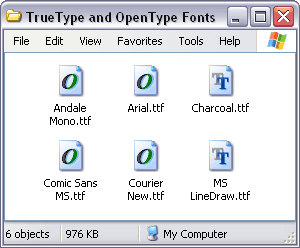OpenType vs. TrueType Fonts
This article will explain the basic differences between OpenType and TrueType fonts.
TrueType
TrueType is an outline font standard originally developed by Apple Computer in the late 1980s as a competitor to Adobe’s Type 1 fonts used in PostScript. TrueType has become the most common format for fonts on both the Mac OS and Microsoft Windows operating systems.
The primary strength of TrueType was originally that it offered font developers a high degree of control over precisely how their fonts are displayed, right down to particular pixels, at various font sizes. With widely varying rendering technologies in use today, pixel-level control is no longer certain in a TrueType font. The TrueType format also allows for the most basic type of digital rights management – an embeddable flag that specifies if author allows embedding of the font file into things like PDF files and websites.
OpenType
OpenType is a format for scalable computer fonts. It was built on its predecessor TrueType, retaining TrueType’s basic structure and adding many intricate data structures for prescribing typographic behavior. OpenType is a registered trademark of Microsoft Corporation.
The specification germinated at Microsoft, with Adobe Systems also contributing by the time of the public announcement in 1996. The specification continues to be developed actively and is presently migrating to an open format.
Because of wide availability and typographic flexibility, including provisions for handling the diverse behaviors of all the world’s writing systems, OpenType fonts are used commonly today on the major computer platforms.
The OpenType font format is designed to overcome cross-platform compatibility problems by making one font format that works on Macintosh and Windows. OpenType is basically an extension of the TrueType format.
OpenType fonts are available in two “flavors” – TrueType or PostScript. TrueType OpenType fonts have a TTF file extension and PostScript OpenType fonts have an OTF file extension. PostScript OpenType fonts use the CFF (Type 2) “Compact File Format” developed by Adobe Systems. This format allows a large number of glyphs to be stored in a relatively small file size. With OpenType you can use PostScript fonts in your page layouts and not have to worry about mismatched or missing screen font / printer font pairs. Plus you can use the exact same font file on either platform.
Sources: Wikipedia.org, Sketchpad.net
